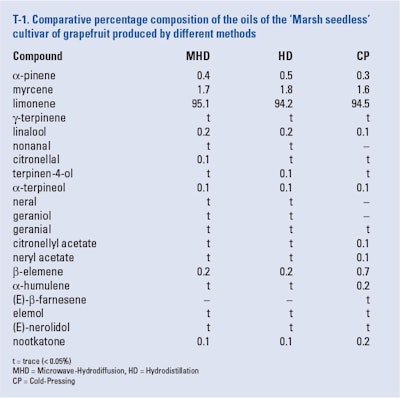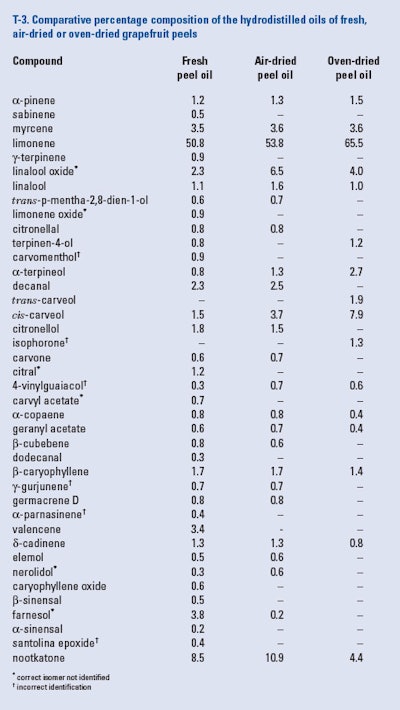
Using GC-FID and GC/MS, Njorge et al. (2005) examined the oil of a manually produced cold-pressed oil of the ‘Red Blush’ cultivar of grapefruit collected from the Kilifi district which is 50km North of Mombassa (Kenya). The constituents characterized in this study that are listed in polar order of elution were:
α-pinene (0.5%)
sabinene (0.4%)
α-terpinene (1.3%)
limonene (91.1%)
octanal (0.3%)
nonanal (0.1%)
heptyl acetate (0.5%)
citronellal (0.2%)
decanal (0.3%)
α-cubebene (0.1%)
linalool (0.1%)
linalyl acetate (0.1%)
α-cedrene (0.1%)
β-caryophyllene (0.1%)
trans-p-mentha-2,8-dienol* (0.2%)
sabina ketone (0.2%)
α-terpineol (0.1%)
carvone (0.4%)
(E, E)-a-farnesene (0.1%)
cuminaldehyde (0.1%)
cis-carveol (0.3%)
carvone (0.1%)
trans-carveol (0.2%)
dodecyl acetate (0.1%)
p-menth-1-en-9-ol (0.1%)
dihydrocarveol† (0.1%)
caryophyllene oxide (0.1%)
(Z)-nerolidol (0.1%)
cinnamaldehyde (0.1%)
elemol (0.1%)
cedrol (0.1%)
nootkatone (0.2%)
† incorrect identification
* correct isomer not identified
In addition, the authors listed two types of trace constituents. The first type were those found in levels of more than 0.005% and less than 0.05%. They were α-thujene, β-pinene, δ-terpinene, terpinolene, 4-methyl-1-octene, myrcene epoxide, (E, Z)-2-6-nonadienol, perillene, trans-sabinene hydrate, γ-elemene, α-copaene, dihydrocarveol, trans-p-mentha-2,8-dien-1-ol, neral, cis-piperitol, dodecanal, geranial, perillaldehyde, nerol, nonanoic acid, b-sinensal, a nerolidol acetate isomer, (Z, E)-farnesol and a-sinensal.
The second type of trace constituents, which were characterized but not quantified, were isothujol, geranyl propionate, perillyl acetate, tetradecanal, a tetradecenal isomer, globulol, limonen-10-ol, a caryophyllene oxide, perillyl alcohol, methyl N-methyl anthranilate and undecanoic acid.
Kirbaslar et al. (2006) examined the composition of a cold-pressed grapefruit oil of Turkish origin using GC/MS and GC-FID. They found that the oil contained the following constituents:
α-pinene (0.2%)
sabinene (0.4%)
β-pinene (0.6%)
myrcene (2.6%)
octanal (0.2%)
limonene (92.5%)
δ-terpinene (0.1%)
linalool (0.2%)
citronellal (0.1%)
α-terpineol (0.1%)
decanal (0.2%)
neral (0.1%)
geranial (0.1%)
neryl acetate (0.1%)
geranyl acetate (0.1%)
α-copaene (0.1%)
β-cubebene (0.1%)
β-caryophyllene (0.4%)
γ-cadinene (0.2%)
nootkatone (0.2%)
In addition, trace amounts (< 0.05%) of a-phellandrene, a-terpinene, nonanal, octyl acetate, geraniol, citronellyl acetate and a-humulene were also found in this oil.
A manually produced cold-pressed oil of grapefruit of Pakistani origin was analyzed by Ahmad et al. (2006) using GC-FID and peak enrichment identification. The constituents that were characterized this way were:
α-thujene (0.2%)
α-pinene (1.3%)
myrcene (6.3%)
α-terpinene (2.1%)
limonene (86.3%)
δ-terpinene (0.1%)
citronellol (0.5%)
decanal (0.3%)
benzaldehyde† (0.1%)
linalool (< 0.1%)
† incorrect identification
A hydrodistilled oil from grapefruit peel obtained from fruit purchased in Ile-Ife (Nigeria) was analyzed using GC-FID and GC/MS by Karioti et al. (2007). The oil was determined to possess the following composition:
a-thujene (0.1%)
a-pinene (0.7%)
sabinene (0.2%)
octanal (0.5%)
limonene (94.2%)
(E)-b-ocimene (0.2%)
δ-terpinene (0.4%)
citronellal (0.1%)
α-terpineol (0.1%)
decanal (0.1%)
α-copaene (0.1%)
β-cubebene (0.1%)
β-caryophyllene (0.2%)
germacrene D (0.1%)
γ-cadinene (0.1%)
Grapefruit oils produced by microwave—hydrodiffusion, hydrodistillation and cold-pressing of the peel of the ‘Marsh Seedless’ cultivar—were the subject of analysis by Bousbia et al. (2009).
The analyses which were performed using GC-FID and GC/MS can be seen summarized in T-1.
Palacios et al. (2009) screened a number of oils for their potential as insecticides against the common house fly. Grapefruit oil, which was one of the oils screened, was analyzed by GC/MS only. The only constituents characterized were:
sabinene (1.2%)
myrcene (2.6%)
limonene (95.0%)
A cold-pressed Spanish grape fruit oil was the subject of analysis by Viuda-Martos et al. (2009). Using GC-FID and GC/MS the authors found that its composition was as follows:
α-pinene (0.5%)
sabinene (0.4%)
myrcene (1.5%)
octanal (0.5%)
limonene (96.2%)
terpinolene (0.1%)
cis-limonene oxide (0.1%)
decanal (0.2%)
β-caryophyllene (0.2%)
Trace amounts (< 0.05%) of a-thujene, b-pinene, a b-ocimene isomer, nonanal, linalool, trans-limonene oxide, a-terpineol, trans-carveol, neral, carvone and germacrene D were also characterized in this same oil.
Flamini and Cioni (2010) analyzed the headspace of the ripe and unripe pericarp and expressed oils also produced from ripe and unripe pericarp of the ‘Marsh’ cultivar of grapefruit collected from an orchard near Pisa (Italy) using GC-FID and GC/MS and two different polarity columns. The results of this study can be seen summarized in T-2.
A hydrodistilled oil of fresh grapefruit peel obtained from fruit grown near Sari (Mazandaran Province, Iran) was analyzed by GC-FID and GC/MS. The oil composition was found to be dissimilar to that normally encountered with the major constituents reported to be myrcene (28.7%) and a b-ocimene isomer (13.4%). This report by Esmaelli et al. (2012) is only included for completeness of a literature search.
Another study on a hydrodistilled peel oil produced from grapefruit collected in Faisalabad (Pakistan) was performed by Khan et al. (2012) using GC/MS only. The oil was reported to contain the following constituents:
α-pinene (1.3%)
benzaldehyde† (2.5%)
myrcene (3.6%)
γ-3-carene (1.1%)
p-cymene (0.6%)
octanol (1.3%)
limonene (40.9%)
4-methyl proline† (2.8%)
terpinolene (19.7%)
ethyl alcohol† (1.6%)
5-acetyl-2-methyl pyridene† (1.1%)
linalool (1.0%)
trans-p-mentha-2,8-dien-1-ol (3.2%)
citronellol (0.6%)
carvone (1.8%)
limonene glycol† (0.3%)
geraniol (6.7%)
perillaldehyde (3.5%)
(Z)-5-nonadecane† (2.2%)
heneicosane (4.5%)
† incorrect identification
Kamal et al. (2011) examined the composition of hydrodistilled oils of grapefruit peel carefully removed from fruit collected in Faisalabad (Pakistan). The oils were produced from fresh, air-dried and oven-dried peel prior to separate hydrodistillation. The oil compositions that were analyzed using GC-FID and GC/MS can be seen summarized in T-3.
A hydrodistilled oil of fresh grape fruit peel puree of Nigerian origin was analyzed using GC/MS only by Okunowo et al. (2013). The constituents characterized in this oil were as follows:
nonane (0.2%)
α-pinene (2.1%)
β-phellandrene† (1.2%)
myrcene (7.3%)
octanal (1.7%)
limonene (75.1%)
γ-3-carene† (0.2%)
cis-linalool oxide (0.3%)
linalool (0.5%)
decanal (1.1%)
tridecane (0.3%)
α-copaene (0.8%)
tetradecane (0.5%)
β-caryophyllene (1.9%)
α-humulene (0.3%)
γ-cadinene (0.3%)
methyl palmitate (0.3%)
methyl oleate (0.2%)
† incorrect identification
Finally, examination of the previous reviews of grapefruit oil (Lawrence 1979, 1983, 1986, 1988, 1991, 1994, 200, 2005), revealed that the composite analysis of cold-pressed grapefruit oil (listed in elution order from a non-polar capillary GC column) is as follows:
α-pinene (0.15–0.75%)
sabinene (0.11–1.20%)
β-pinene (0.01–0.26%)
octanal (0.01–0.79%)
myrcene (0.60–1.98%)
heptanal (< 0.01–0.30%)
α-terpinene (< 0.01%)
p-cymene (0.01–0.40%)
limonene (78.84–96.18%)
(E)-b-ocimene (0.01–0.31%)
δ-terpinene (0.01–0.23%)
nonanal (0.01–0.15%)
linalool (0.01–0.40%)
cis-linalool oxidef (< 0.01–0.28%)
trans-linalool oxidef (< 0.01–0.90%)
citronellal (0.01–0.14%)
terpinen-4-ol (0.01–0.20%)
α-terpineol (0.01–0.23%)
decanal (0.01–0.51%)
octyl acetate (< 0.01–0.07%)
nerol (< 0.01–0.07%)
neral (0.01–0.11%)
geraniol (< 0.01–0.05%)
geranial (0.01–0.13%)
neryl acetate (0.01–0.20%)
α-copaene (0.01–0.16%)
geranyl acetate (0.01–0.13%)
β-cubebene (< 0.01–0.06%)
β-elemene (< 0.01–0.09%)
dodecanal (0.01–0.22%)
β-caryophyllene (0.07–0.34%)
(E)-b-farnesene (< 0.01%)
germacrene D (0.01–0.25%)
γ-cadinene (0.01–0.13%)
elemol (< 0.01–0.04%)
β-sinensal (< 0.01–0.01%)
(Z, Z) farnesol (< 0.01%)
nootkatone (0.07–0.74%)













